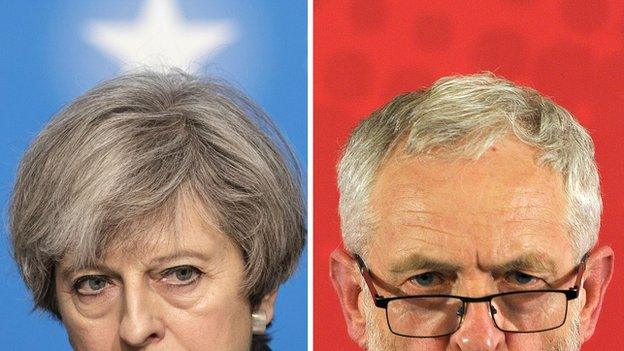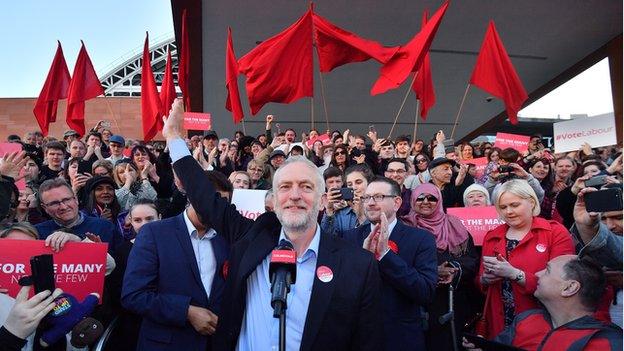Election 2017: Does Tories' campaign schedule betray a loss of confidence?
- Published

In recent weeks, there has been a pronounced change in the polls. Not only has Labour eaten up ground on the Conservatives, but we are seeing major variation in estimates between pollsters releasing data on the same day. Are the Tories three points ahead of Labour - or 12?
My colleague Peter Barnes has written about some of the underlying reasons why pollsters are getting such different numbers. But knowing why the pollsters disagree does not help the tactical voter (or, less nobly, the punter at the bookmaker) work out which of them is correct. So can we help answer that question using data on where the national campaigns are actually visiting?
The intuition here is this: political parties have information that we do not. They spend lots on data analysis and polling. Canvassers feed data back to the central machine, which is used to inform voting decisions. If they are using their campaign resources (or "politicians", as they like to be called) effectively, we should see them moving to places where they think the fight is significant.
We have been doing this before: I have written before about the fact that Jeremy Corbyn and Theresa May appeared to disagree quite fundamentally about which sorts of seats this election is being fought in. That is to say, they are visiting different places to campaign.
Both leaders are crossing the country, but not quite in the same way. You can explore where they have been in these maps - but I'll give you my attempt to unpick the patterns below.
NOTE: These maps have been updated to include visits made up to 7 June, the final day of election campaigning.
Sorry, your browser cannot display this map
Sorry, your browser cannot display this map
The campaign battleground
To understand the pattern a bit better, let us start with this chart - which is a bit like a swingometer. Each block represents a Tory-facing Labour seat (in red) or a Labour-facing Tory seat (in blue). And each stack of blocks tells you how many seats each party gains if they improve their polling, in two percentage points increments. Seats near the dotted middle line are more marginal. Seats further away are safer.
We can then overlay this with black markers, which show all the places that Jeremy Corbyn and Theresa May have visited.

Here is the state of play, as it stood prior to the Conservative manifesto launch on 18 May.
The overall pattern was clear: Theresa May was hammering away with visits which imply she thought the Tories were going to advance a long way. She visited few Tory-held seats, on the right of the graph. But she also visited lots of Labour-held ones, on the left. And it was not just easy marginals that require little swings, either. She even visited seats far to the left of the graph, notionally safe Labour seats.
The early May strategy is simple to read: it was in line with the polls at the time. Even the hyper-ambitious trips - such as to Leeds East, where Labour has a 30-point lead - were comprehensible if the Conservatives believed they could hoover up huge numbers of ex-UKIP voters. (That one very safe Tory seat she attended events in is Maidenhead, her own seat.)
Jeremy Corbyn's strategy, meanwhile, was harder to read. He visited marginal Tory-held seats, such as Croydon Central. That implied he thought they could make some progress. But he also visited a lot of very safe Labour seats, such as Birmingham Ladywood. It is, at the least, a more complex strategy than the Tories. It might, as I suggested before, possibly have been built around optimising pictures of Mr Corbyn for TV.

Jeremy Corbyn campaigning in Manchester
Since the manifesto launch
Since then, though, there has been a squeeze on the Tory lead. YouGov - the pollster which has seen the most dramatic move - implies the Tory lead has dropped from an average of 13 points on the manifesto launch day to around three or four points today. The Tory manifesto - and the U-turn that followed - went down rather poorly.
The terror attack on Manchester meant that there have been relatively few visits since the manifesto. But the pattern, such as it is, between the manifesto launch and the end of May was as below.

This suggests Labour appears to be pursuing the same strategy as before. That may reflect the fact that whatever they're doing, it's working at driving up their poll share. It is still that combination of Tory-held marginals like Watford and safe seats like Liverpool Riverside.
The striking thing, though, is that it looks, at first sight, like the Tories have reined in their ambitions. And I think that is a reasonable reading of what has happened. Their most ambitious trip has been to Wolverhampton North East - where the Labour lead is under 20 points. They're not fighting the same range of seats as they were before the manifesto launch. They're not going as far to the left of the graph.
The scaling back does appear to have coincided with the Tory manifesto launch. You can see that most clearly if you look at visits in the week immediately beforehand.

Just before the manifesto launch, they were campaigning in North Tyneside. That is roughly twice as ambitious as their most post-manifesto trip. That said, the Conservatives are behaving as though they still expect to win a decent number of extra seats - and are certainly not behaving as though they think we are heading to a hung parliament.
Two other things have remained consistent over the campaign.
First, the prime minister continues to run a fairly active defensive campaign against the Liberal Democrats. Since the manifesto launch, she has perhaps been putting more effort into defence against the Lib Dems than the publicly available polling would seem to justify.
One seat worth watching is Richmond Park. For consistency's sake, we have listed it as a Tory seat, because it was held by Zac Goldsmith at the 2015 election. But the Lib Dems have since taken it at a by-election.

Second - and we have not bothered to draw a graph of this - she has not been to Scotland very much. But one advantage that the Conservatives have over the Scottish National Party is rather simple: they have two leaders. One - the prime minister - can appeal to Scotland's (often ignored) pro-Brexit voters. And one - Ruth Davidson - who can go to other places.
That's one of the many reasons why the Scottish results may supply us with our biggest shocks on 8 June.
Additional reporting by Jack Evans, Daniel Dunford and Nassos Stylianou.